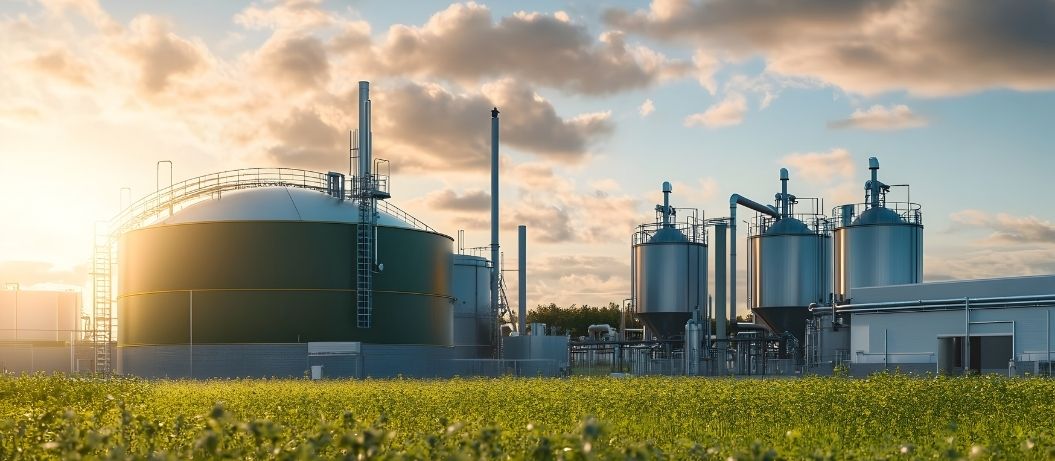Common causes of foaming in AD plants:
– Overfeeding/sudden change in diet
– Temperature or pH fluctuations
– Poor flow and mixing control, which can cause;
– Crusting and layer formation.
Advanced AD and Clean Energy; a challenge worth getting right
Anaerobic digestion (AD) is a well-proven method of turning waste biomass into valuable, renewable energy. It’s importance to the renewable energy mix is growing, as the sector injects increasing amounts of Biomethane into the UK gas grid.
However, as anyone involved in the process can attest, the AD process is not without its problems. The entire journey, from inputs—typically sewage sludge, food waste, and agricultural by-products—to outputs- of heat energy, green electricity, and high-purity methane, involves numerous processes.
AD plants are surely one of those sectors that rely heavily on all branches of science; its biology, chemistry and physics in practically equal parts. Successful AD and Biogas plants must have access to experts in all these fields, and the various processes are tightly intertwined. Typically, any one issue has a knock-on effect throughout the process.
This article outlines one of the most feared issues encountered in AD and Biogas facilities – foaming incidents. It also reveals proven methods and approaches deployed to avoid or overcome them, alongside a discussion of the latest technology and some new methods currently being trialled.
Foaming in AD Digestors
The fear of a foaming incident probably keeps AD managers awake at night more than anything else, and it’s easy to understand why.
Foaming incidents can cause severe costs to an AD facility, as it can take days or even weeks to right the ship. The costs can include loss of biogas production, re-routing feedstock to other treatment plants or storage, safely tackling the foam with chemical or physical dispersal methods, and restarting the AD process.
Dense foam buildup can also cause damage to membranes, pipes, valves, and pumping equipment – even destroying expensive CHP generators and gas separation systems, if the buildup is not stopped in time.
This sticky, ever-growing mass is like a real-life version of the magic porridge pot, only less appetising!
What can lead to foaming incidents?
As the digestate ‘soup’ breaks down, it releases gases including hydrogen, carbon dioxide and methane. During regular operation, these gases steadily rise as bubbles which break on the surface and collect at the top of the digestor tank.
The microbes that perform this work rely on a consistently favourable environment: zero oxygen, a steady supply of ‘feed’, with the optimal pH value and temperature range that suits their type. With so many parameters involved, it doesn’t take much to knock the system off-balance.
What happens when the system gets off balance? Certain conditions can prevent bubbles from bursting on the digestate surface, resulting in a rapid creation of a growing ‘head’ of foam and causing the dreaded ‘foaming incident’.
Foaming incidents are often the result of system or process shock, which leads to an upset of the bacterial process. This could be caused by:
• Overloading with feedstock
By “overloading” we mean feeding the digester with overly nutritious substrate, although it could also be a case of pumping in at too high a flow rate. This increases the food-to-microbe ratio (F/M) out of optimal range.
When the rate of breakdown rapidly increases, this can lead to an overload at the next stage of digestion, with the microbes there unable to digest fast enough to keep up.
A spike in the amount of protein or lipid content available creates a surge in volatile fatty acid production (VFAs), which can predispose the liquor to foaming.
The solution to overfeeding is to pre-mix and test the feedstock, blending the available material to maintain a steady ratio of carbohydrates, proteins and lipids. Sourcing a steady supply of the ideal feedstock can be a challenge, making the procurement and supply chain a critical area for AD companies to work on.
Any changes to the AD diet need to be phased in, which is where pre-blending the input matter from various batches is key.
Trace elements are available to address deficiencies in the AD diet, and the blending of returned activated sludge (RAS) from the discharge end helps smooth out variances between intake batches.
• Mechanical/physical changes to flow
Breakdowns or flow-performance issues of pumps or digester mixers can create uneven concentrations and lead to localised over- and under-activity.
Slow and steady mixing wins the day with biological processes. It’s generally best to avoid turbulent flows, which can exacerbate foaming by entraining more gas, although controlled pulsation can help break up persistent layers and crust formations.
Keeping shear-stress to a minimum will help control foam; this is achieved through careful pump selection, and pipework specification.
Traditionally, most AD plants in the UK use in-tank mixers to keep the liquid homogeneous and prevent layer formation in the digestor. However, their motors are positioned at height and the internal mixing paddles are submerged inside the tank, making maintenance and even inspection no easy task.
One alternative that’s being trialled in place of conventional digester mixers is fully external, ground-level LSM pumps. With only the pipes inside the tank and no moving parts in direct contact with the digestate, this concept looks to radically improve the operational burden and risk management of tank mixer maintenance.
• Temperature or pH fluctuations
The optimum temperature and pH ranges for each stage of the AD process are important, as foaming can occur if this gets out of hand. Depending on the feedstock and outputs desired, a single point or even half a point in pH value can be a big deal.
If the balance of activity between the acidogenesis and methanogenic stages is disrupted, it can cause problems in the balance of microbial activity. For example, increased activity of acidogens, at the expense of later-stage acetogenic or methanogenic activity is a common cause of foaming.
Any sudden shift in temperature or pH can slow down the process, as the microbes require time to adapt to the new conditions. This can result in lower throughput and reduced gas yield, which can take some time to correct. Avoid this by closely monitoring parameters and taking remedial action as soon as a trend is spotted..
Monitoring software like Senteos provides real-time data, alerts, and pre-programmed actions to automatically take remedial action, such as pump control. For example, it can be set up to send a text alert if the pH moves away from the optimum. Then, if the measurement continues to deteriorate, a dosing pump will dispense a buffer solution when the ‘hard’ limit is reached.
Filamentous crusts – a precursor to foaming
The growth of unhelpful filamentous bacteria can be unwittingly promoted, especially in mesophilic AD sites processing mixed waste streams.
These floating, thread-like bacteria cells will exploit any lack of mixing to form a crust on the surface of the fermenting digestate, which can trap gas underneath until the pressure bursts through it.
Most filamentous bacteria strains aren’t typically foam-causing themselves, but they can create the conditions for it and act as a foam stabiliser once an incident starts.
Initially, the crust causes a reduction in gas yield, then as the pressure mounts, a sudden burst of gas is released, generating foam like a can of shaving cream.
Various technologies are used to mechanically deal with crust layers and struvite buildup, including surge pumping, pressure jet, and even submersible cleaning robots.
Mixer selection is critically important in avoiding layers and foam-friendly conditions; low-shear and high torque is better than rapid-speed mixing.
Downtime of equipment needs to be kept to a minimum as crusts are more likely to form when the system isn’t in a normal flow state. Conduct regular inspections of moving parts, especially those that are in constant contact with the media (wet-parts), such as seals, mixer shafts, and pump rotors.
Variable speed drives (VSDs) are becoming more popular as they allow fine-tuning of flow and mixing intensity, and also energy consumption optimisation.
Chemical treatment of filamentous bacteria is often not compatible with AD, as the beneficial bacteria are also harmed. However, there are some anti-surfactant foam-breaking agents available on the market that may be suitable for your system.
Where filamentous bacteria are thriving, a gradual increase of temperature by 1 or 2°C can help disintegrate the scum and inhibit its further growth.
From the bio-control side, reducing the amount of fatty content can reduce the formation of crust, but this may not be easy to achieve in treatment plants that have less control of feedstock content, such as food waste facilities.
Conclusion: Avoidance is key
AD operators work hard to ensure trouble-free operation of their plant at all times, using knowledge and skillsets from many branches of science and engineering.
⚙️Equipment choice and maintenance goes a long way to smoother AD processes.
📉Continuous monitoring of key parameters enables you to build a picture of normal operations and allows you to spot signs of trouble early on.
🌡️Controlling a stable temperature, flow-rate, mixing speed, and loading rate is essential for maintaining foam-free, effective AD processes.
Senteos is an online system that connects multiple sensors to give you a real-time dashboard, alerts, and remote or automated equipment switching.
If you’d like to try LSM pumps out on your own AD plant, Atlantic Pumps have a hire fleet, enabling you to see for yourself how they operate on sludge forwarding and recirculation duties.
Connect with a AD pump advisor to discuss your issues and requirements.
We also take a sustainable approach to our work and are committed to reducing energy waste from pumps. Our expert knowledge allows us to reduce energy usage by 20% on the average site!
Call us today on 0808 196 5108 for more information.
 November 19 2025
November 19 2025 5 Minutes min read
5 Minutes min read


